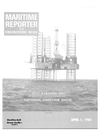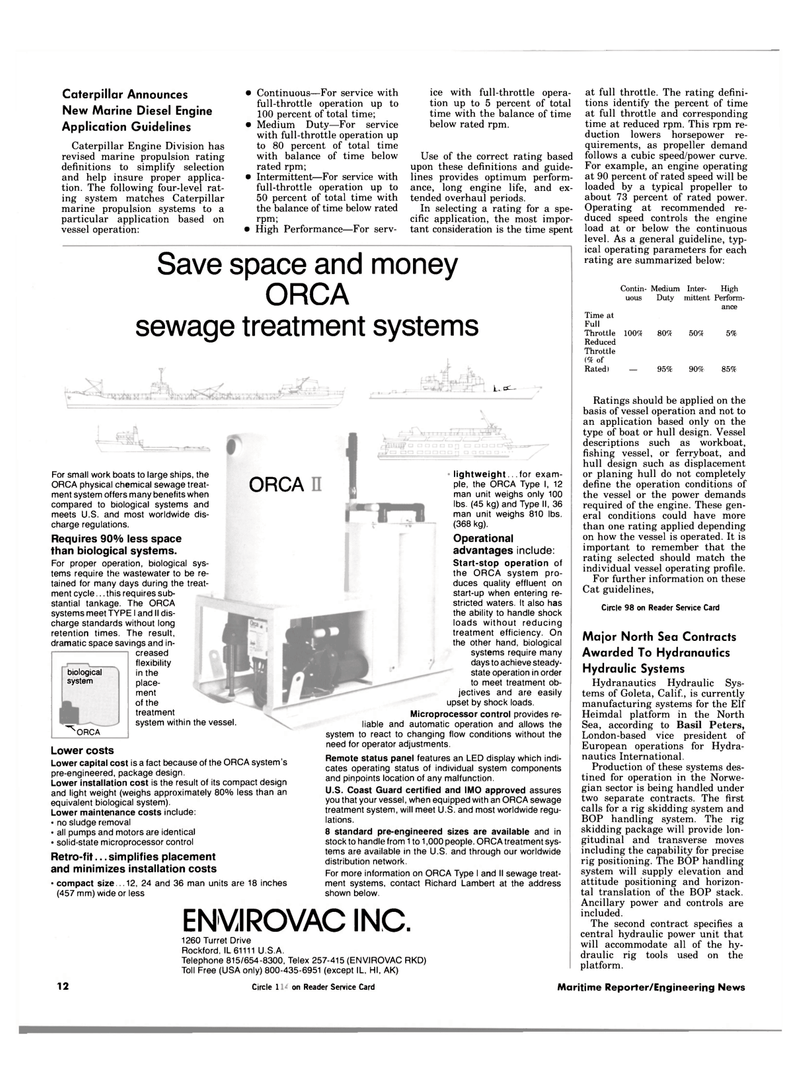
Page 10: of Maritime Reporter Magazine (April 1984)
Read this page in Pdf, Flash or Html5 edition of April 1984 Maritime Reporter Magazine
Caterpillar Announces
New Marine Diesel Engine
Application Guidelines
Caterpillar Engine Division has revised marine propulsion rating definitions to simplify selection and help insure proper applica- tion. The following four-level rat- ing system matches Caterpillar marine propulsion systems to a particular application based on vessel operation: • Continuous—For service with full-throttle operation up to 100 percent of total time; • Medium Duty—For service with full-throttle operation up to 80 percent of total time with balance of time below rated rpm; • Intermittent—For service with full-throttle operation up to 50 percent of total time with the balance of time below rated rpm; • High Performance—For serv- ice with full-throttle opera- tion up to 5 percent of total time with the balance of time below rated rpm.
Use of the correct rating based upon these definitions and guide- lines provides optimum perform- ance, long engine life, and ex- tended overhaul periods.
In selecting a rating for a spe- cific application, the most impor- tant consideration is the time spent
Save space and money
ORCA sewage treatment systems _L
For small work boats to large ships, the
ORCA physical chemical sewage treat- ment system offers many benefits when compared to biological systems and meets U.S. and most worldwide dis- charge regulations.
Requires 90% less space than biological systems.
For proper operation, biological sys- tems require the wastewater to be re- tained for many days during the treat- ment cycle... this requires sub- stantial tankage. The ORCA systems meet TYPE I and II dis- charge standards without long retention times. The result, dramatic space savings and in- creased
ORCA biological system ^ORCA flexibility in the place- ment of the treatment system within the vessel.
Lower costs
Lower capital cost is a fact because of the ORCA system's pre-engineered, package design.
Lower installation cost is the result of its compact design and light weight (weighs approximately 80% less than an equivalent biological system).
Lower maintenance costs include: • no sludge removal • all pumps and motors are identical • solid-state microprocessor control
Retro-fit... simplifies placement and minimizes installation costs • compact size. . . 12, 24 and 36 man units are 18 inches (457 mm) wide or less lightweight... for exam- ple, the ORCA Type I, 12 man unit weighs only 100 lbs. (45 kg) and Type II, 36 man unit weighs 810 lbs. (368 kg).
Operational advantages include:
Start-stop operation of the ORCA system pro- duces quality effluent on start-up when entering re- stricted waters. It also has the ability to handle shock loads without reducing treatment efficiency. On the other hand, biological systems require many days to achieve steady- state operation in order to meet treatment ob- jectives and are easily upset by shock loads.
Microprocessor control provides re- liable and automatic operation and allows the system to react to changing flow conditions without the need for operator adjustments.
Remote status panel features an LED display which indi- cates operating status of individual system components and pinpoints location of any malfunction.
U.S. Coast Guard certified and IMO approved assures you that your vessel, when equipped with an ORCA sewage treatment system, will meet U.S. and most worldwide regu- lations. 8 standard pre-engineered sizes are available and in stock to handle from 1 to 1,000 people. ORCA treatment sys- tems are available in the U.S. and through our worldwide distribution network.
For more information on ORCA Type I and II sewage treat- ment systems, contact Richard Lambert at the address shown below.
ENVIROVAC INC. 1260 Turret Drive
Rockford, IL 61111 U.S.A.
Telephone 815/654-8300, Telex 257-415 (ENVIROVAC RKD)
Toll Free (USA only) 800-435-6951 (except IL, HI, AK) at full throttle. The rating defini- tions identify the percent of time at full throttle and corresponding time at reduced rpm. This rpm re- duction lowers horsepower re- quirements, as propeller demand follows a cubic speed/power curve.
For example, an engine operating at 90 percent of rated speed will be loaded by a typical propeller to about 73 percent of rated power.
Operating at recommended re- duced speed controls the engine load at or below the continuous level. As a general guideline, typ- ical operating parameters for each rating are summarized below:
Contin- Medium Inter- High uous
Time at
Full
Throttle 100%
Reduced
Throttle (% of
Rated) —
Duty mittent Perform- ance 80% 95% 50 % 90% 5% 85%
Ratings should be applied on the basis of vessel operation and not to an application based only on the type of boat or hull design. Vessel descriptions such as workboat, fishing vessel, or ferryboat, and hull design such as displacement or planing hull do not completely define the operation conditions of the vessel or the power demands required of the engine. These gen- eral conditions could have more than one rating applied depending on how the vessel is operated. It is important to remember that the rating selected should match the individual vessel operating profile.
For further information on these
Cat guidelines,
Circle 98 on Reader Service Card
Major North Sea Contracts
Awarded To Hydranautics
Hydraulic Systems
Hydranautics Hydraulic Sys- tems of Goleta, Calif., is currently manufacturing systems for the Elf
Heimdal platform in the North
Sea, according to Basil Peters,
London-based vice president of
European operations for Hydra- nautics International.
Production of these systems des- tined for operation in the Norwe- gian sector is being handled under two separate contracts. The first calls for a rig skidding system and
BOP handling system. The rig skidding package will provide lon- gitudinal and transverse moves including the capability for precise rig positioning. The BOP handling system will supply elevation and attitude positioning and horizon- tal translation of the BOP stack.
Ancillary power and controls are included.
The second contract specifies a central hydraulic power unit that will accommodate all of the hy- draulic rig tools used on the platform. 12 Circle 218 on Reader Service Card Maritime Reporter/Engineering News

 9
9

 11
11
